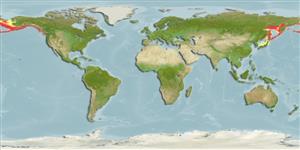Preferred temperature (Ref.
123201): 0.2 - 6.1, mean 3.4 °C (based on 33 cells).
Phylogenetic diversity index (Ref.
82804): PD
50 = 0.6250 [Uniqueness, from 0.5 = low to 2.0 = high].
Bayesian length-weight: a=0.00832 (0.00722 - 0.00958), b=3.08 (3.04 - 3.12), in cm total length, based on LWR estimates for this species (Ref.
93245).
Nível Trófico (Ref.
69278): 3.5 ±0.1 se; based on diet studies.
Generation time: 7.8 (6.8 - 11.0) years. Estimated as median ln(3)/K based on 12
growth studies.
Resiliência (Ref.
120179): Muito baixo, tempo mínimo de duplicação da população maior que 14 anos (K=0.1-0.15; tm=4-10; tmax=34; Fec=1 million).
Prior r = 0.27, 95% CL = 0.18 - 0.40, Based on 7 full stock assessments.
Fishing Vulnerability (Ref.
59153): Moderate to high vulnerability (50 of 100).
🛈
Climate Vulnerability (Ref.
125649): Low vulnerability (23 of 100).
🛈
Nutrients (Ref.
124155): Calcium = 12.4 [5.7, 51.3] mg/100g; Iron = 0.246 [0.127, 0.464] mg/100g; Protein = 15.7 [13.4, 18.4] %; Omega3 = 0.36 [0.18, 0.74] g/100g; Selenium = 13.5 [4.6, 46.8] μg/100g; VitaminA = 9.24 [1.88, 45.54] μg/100g; Zinc = 0.298 [0.160, 0.721] mg/100g (wet weight); based on
nutrient studies. 